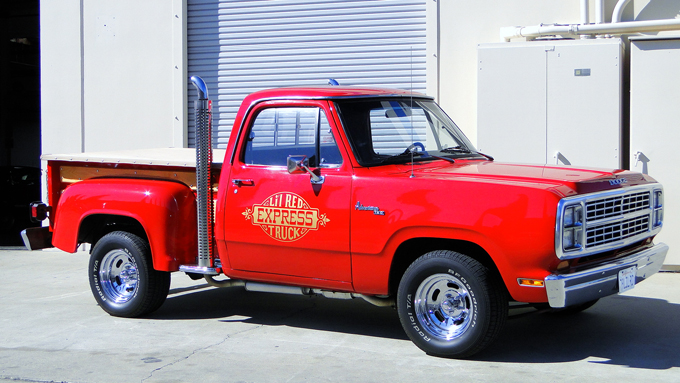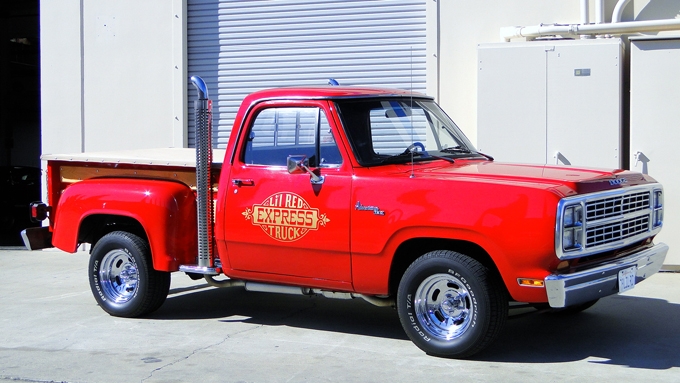
Production of the Li’l Red Express was 5,118 in 1979. Most of the features remained from the 1978 model, but there were some changes that included a catalytic converter, unleaded gas and an 85 mph speedometer. The most noticeable changes were the flat hood and dual square headlights replacing the round versions, and the 1979 models rode on raised white-letter tires mounted to eight-inch chrome wheels.
This is a three-owner truck with 78,950 original miles. It has great paint, and it’s all stock. Meticulously maintained and fitted with new tires. All-original paperwork includes build sheet, bill of sale and owner’s books. The truck drives great, and the wood trim is outstanding along with the bed, chrome and trim. Fully serviced and detailed.
(Introductory description courtesy of Barrett-Jackson.)
SCM Analysis
Detailing
| Vehicle: | 1979 Dodge Li’l red express |
| Years Produced: | 1978–79 |
| Number Produced: | 2,188 (1978), 5,118 (1979) |
| Original List Price: | $8,239 |
| SCM Valuation: | $15k–$23k |
| Tune Up Cost: | $150 |
| Distributor Caps: | $9 |
| Chassis Number Location: | On radiator support under hood |
| Engine Number Location: | Left side of block, below cylinder head. Engine pad on right side of block should be blank for a factory Li’l Red 360 engine |
| Club Info: | National Association of Li’l Red Express Truck Owners |
| Website: | www.lilredexpress.org |
| Alternatives: | 1972 Chevrolet Cheyenne Super, 1990 Chevrolet Silverado 454SS, 1993 Ford SVT Lightning |
| Investment Grade: | C |
This Li’l Red Express, Lot 33.1, sold for $11,000, including buyer’s premium, at Barrett-Jackson’s Orange County auction in Costa Mesa, CA, on June 22–24, 2012.
The muscle car’s demise was more or less complete by the mid-1970s. Gone were the LS6s, 426 Hemis and high-compression Boss 302s from dealers’ lots, and in their place were detuned basic V8s set up for clean running and slightly better fuel mileage. By 1975, even the final few holdouts, the Corvette and Trans Am, were really just shadows of their former selves, at least in terms of brute power.
New emissions regulations and high insurance premiums were the root cause. Owning anything with a big-block engine meant you paid an arm and a leg to insure it. Finally, smog pumps combined with small-port cylinder heads, retarded timing, and catalytic converters took a lot of the fun out of large-displacement engines in the name of lower tailpipe emissions.
Truck-sized loopholes
Hot rodders tend to be pretty bright people, and Mopar’s engineers of the ’60s and ’70s could certainly be considered hot rodders. One in particular, Tom Hoover, known for his development work on the legendary 426 Hemi a decade earlier and one of the founding members of the Ramchargers, was asked by Dodge in the late 1970s to liven up their truck market. He started by taking a careful look at the EPA regulations imposed on production cars in the mid-’70s.
According to the rules, light trucks were exempt from catalytic converters if they had a gross vehicle weight of more than 6,000 pounds. In addition to that, several modifications to engines were allowed once an engine family had been certified as compliant by the EPA — the engineers could change six to nine things before the engines would need to be recertified for production.
Bending the rules
A light bulb went off for Hoover —Dodge’s 1978 D-150 short-bed stepside truck had a GVW of 6,050 pounds, which got it away from needing cats, and the police-spec 360 was already legal and compliant with the EPA regulations. Why not put them together?
Hoover teamed up with Dick Maxwell and Dave Koffel to build a prototype. Their truck featured a 360-ci engine with W-2 cylinder heads from the Direct Connection parts bin, a special cam similar to the one used in the ’68 340, a special 727 auto with a 2,500-rpm stall, and cold air induction. Finishing off the package were a pair of chrome stacks behind the cab.
Dodge produced the truck, minus the special heads, as a ’78 model. It was named the Li’l Red Express, and was sold alongside the Warlock and Macho Power Wagon, all of which Dodge branded as “Adult Toys.” A total of 2,188 Li’l Red units were sold that first year. For ’79, the loophole closed a bit, and cats were installed, but 5,118 of these trucks were still built and sold. The option disappeared completely by 1980, thanks to the fuel crisis and the very first dollar-plus gallons of gas.
Stacking up to the competition
A pre-production version of the truck was tested by Hot Rod and Car and Driver, and it was found to be the fastest American-built vehicle to 100 mph that year, running the quarter mile in 14.7 seconds at 93 mph. The production truck was detuned, but it still put out 225 net horsepower, which was enough to run the quarter mile in 15.7 seconds at 88 mph — not bad for a production pickup, considering the hottest Corvette in 1978, the L82, had 220 horsepower and ran that same quarter in 15.2 seconds at 95 mph.
Just as important were insurance rates. This was basically a D-150 pickup. Most insurance companies hadn’t ever heard of a muscle truck, so rates were reasonable, which made these trucks pretty attractive to buyers in the market for performance.
Rare, but an acquired taste
Our feature truck is a ’79, which makes it a little less desirable due to a further detuning over the initial model and a greater production number. But these trucks are still relatively rare, and they’re certainly on the short list of collectible American cars and trucks from their era.
However, you’re certainly not going to blend in while driving one of these. The Canyon Red paint with gold trim and oak panels tend to draw attention, and the stack exhaust is loud, so you can expect people to hear you coming. But that’s not necessarily a bad thing.
The market for trucks has been expanding, but we’ve seen prices on the Li’l Red Express stay relatively flat, with the best examples bringing right around $18k on a good day. Their genesis is a great story, but at the end of the day, they just can’t compete with some of the earlier Mopar muscle, and as trucks, there isn’t much you’d really want to haul in one.
However, considering this one’s condition and its documentation, I’d say the new owner got a screaming deal for $11k. It’s no Hemi ’Cuda, but it is genuine Mopar muscle nonetheless, and it’s a great example of what can be done when designers and engineers look past the rules and think outside the box. Very well bought. 
